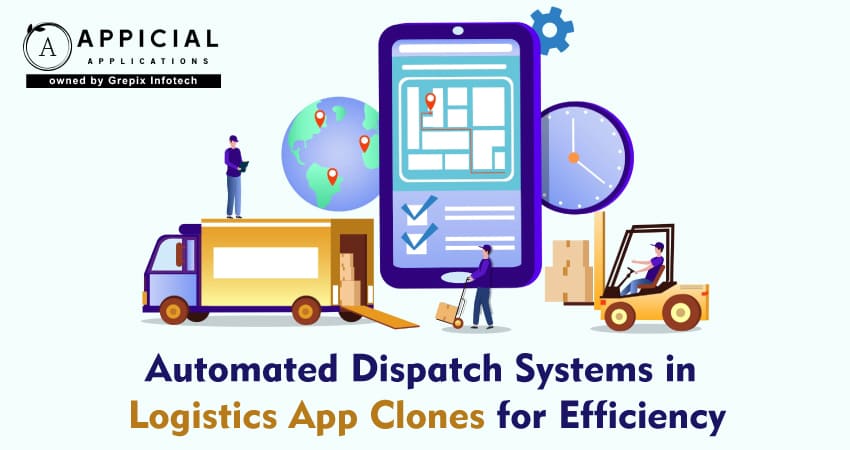
Automated Dispatch Systems in Logistics App Clones for Efficiency
Let’s be honest!
If you've ever managed logistics manually, you know how chaotic it can get. Phone calls flying in. Drivers waiting. Customers complaining. A good day feels like you’re playing whackamole with delivery issues.
That’s where automated dispatch logistics systems step in.
Think of it as your logistics command center on autopilot without losing control. An automated dispatch logistics system assigns delivery tasks, tracks vehicle movements, updates ETAs, and communicates with drivers without the dispatcher needing to lift a finger after setup.
Sounds dreamy? It kind of is.
In a logistics app clone dispatch system, this automation gets baked into the very DNA of the app. So, whether you're building the next Uber for deliveries or launching a B2B logistics platform, you're stepping into the game with some serious tech firepower.
But why does it matter so much right now?
Because logistics isn't just about moving things from A to B anymore. It’s about doing it faster, cheaper, smarter, and with fewer hiccups. As customer expectations rise and margins shrink, logistics app efficiency becomes a survival skill, not just a nicetohave feature.
Let’s break this down.
In today's fastpaced logistics world, speed and precision are everything. This blog explores how automated dispatch logistics technology built into logistics app clone dispatch systems is revolutionizing operations across the board. From streamlining daily deliveries to reducing errors and overhead costs, we dive deep into how this tech is reshaping logistics. We cover the nuts and bolts, the realworld benefits, and strategies for implementing it. Plus, we throw in a few compelling case studies to bring everything into focus. Stick around till the end, and we’ll also show you how Appicial Applications can help you get a head start with your own clone app.
Real Benefits for Logistics Operations: Why Automated Dispatch Is a GameChanger
When you talk to people in the logistics trenches, they’re not dreaming of flying trucks or teleportation. They just want things to run smoother. And that's where automated dispatch logistics systems start earning their keep.
1 LightningFast Assignments
Forget spreadsheets and sticky notes. With automation, orders get dispatched to the nearest available driver based on factors like current location, delivery volume, route traffic, and even driver performance. This drastically improves logistics app efficiency.
2 Fewer Human Errors
People get tired. Computers? Not so much. A logistics app clone dispatch system ensures tasks don’t slip through the cracks. No forgotten deliveries, no double bookings, and no manual miscalculations.
3 Live Tracking and ETA Updates
Customers love transparency. And dispatch managers? Even more. Automation keeps all stakeholders updated in realtime. Everyone knows where a package is and when it’ll land on a doorstep.
4 Dynamic Route Optimization
Traffic. Weather. Road closures. A smart automated dispatch logistics platform considers all of this and reroutes drivers accordingly, often saving hours each day.
5 Reduced Operational Costs
All this efficiency adds up. Fewer delays. Less fuel waste. Lower customer support load. When every minute counts, automation means money saved.
6 Better Driver Management
With digital records and analytics, it's easy to track driver performance, understand delivery trends, and plan smarter schedules. No more guesswork.
7 Enhanced Customer Experience
At the end of the day, faster, more accurate deliveries mean happier customers. And in logistics, customer satisfaction is your best business card.
Strategies for Implementing Automated Dispatch in Your App Clone
Here’s the truth: it’s not just about having an automated dispatch logistics system. It’s about using it right.
A lot of logistics startups throw automation into the mix, but things go sideways because the foundation wasn’t solid. Here’s how to do it the smart way:
1 Choose the Right Technology Stack That Plays Nice with Logistics Demands
Your tech stack is your foundation. Pick the wrong one, and you’re building your dispatch system on sand. The right stack should be scalable, flexible, and mobilefirst because your users, especially your drivers, will mostly interact with it on the go.
What should you look for?
- React Native: Perfect for crossplatform development. Why build two apps when one codebase can run smoothly on both iOS and Android?
- Node.js: Fast, lightweight, and realtimefriendly essential for features like live tracking and dynamic dispatching.
- Firebase or AWS: Cloudbased backends offer excellent scalability and reliable data syncing in real time.
2 Start with a Minimum Viable Product (MVP) and Grow From There
Here’s a common trap: trying to launch a fullblown logistics empire right out of the gate. Don’t. That’s like trying to run a marathon without ever jogging around the block.
Start with a Minimum Viable Product a clean, simplified version of your logistics app clone dispatch system that nails the essentials:
- Automated driver assignment
- Realtime order and vehicle tracking
- Basic route optimization
Focus on the workflows that directly affect logistics app efficiency. You can always add bells and whistles multidepot routing, advanced analytics, driver performance scoring after you've nailed the basics.
3 Integrate AI for Predictive, Smarter Dispatch Decisions
Let’s be clear: automation is great, but intelligent automation is better. AI makes your automated dispatch logistics system not just fast, but smart.
Here's what AI can do when used right:
- Predict peak delivery times based on traffic, weather, and delivery history
- Identify driver availability patterns and autoadjust schedules
- Autosuggest the most efficient dispatching logic based on realtime and historical data
The beauty? Over time, your logistics app clone dispatch system gets smarter. The more data it collects, the better it performs. You’re not just automating you’re futureproofing your operations.
4 Customize Workflows to Fit Your Operational DNA
No two logistics businesses run alike. That’s why rigid, onesizefitsall systems fall flat. Your logistics app clone dispatch system needs to mirror your workflows, not the other way around.
Customization isn’t just a convenience it’s critical. A logistics app clone dispatch system that can’t adapt to your reality will only slow things down. Build for flexibility. Or better yet, partner with a dev team that understands logistics.
5 Prioritize a Seamless User Experience (UX) for Everyone
Let’s talk about interfaces. Fancy dashboards and hightech features are meaningless if they confuse the heck out of your users.
Your UX needs to work for three main groups:
- Dispatchers: They need clear visibility of fleet status, driver location, and delivery queues. Clunky dashboards will slow down decisionmaking.
- Drivers: Give them intuitive job views, easy status updates, and builtin GPS routing. No one wants to fumble through 10 taps while driving.
- Customers: Simple order tracking, realtime ETAs, and instant notifications. That’s what they expect now, thanks to companies like Uber and Amazon.
In short, make your logistics app efficiency measurable by how little your users have to think to get things done.
6 Test, Break, Learn, Improve Then Repeat
Don’t make the mistake of launching and calling it a day. The best automated dispatch logistics setups evolve over time. Testing and iteration should be baked into your rollout plan from day one.
Here’s a rough rollout playbook:
- Phase 1: Internal Beta – Let your own staff use the app in realworld conditions. You’ll spot issues fast.
- Phase 2: Soft Launch – Release the app to a small group of users. Watch how they interact. Collect data obsessively.
- Phase 3: Full Launch + Continuous Updates – Release updates based on feedback. Kill bugs. Improve features. Expand intelligently.
Also Read: Predictive Maintenance in Logistics App Clones Using AI
RealWorld Case Studies: Seeing Dispatch Automation in Action
Let’s talk real talk. Theories are great, but results are better. Here are a couple of examples of businesses that made the leap and saw big wins.
Case Study 1: QuickMove Courier Services – A MidSized Regional Player
QuickMove had a solid reputation but was stuck in the Stone Age when it came to dispatch. Everything was manual calls, scheduling, even route planning.
What they did: They implemented a logistics app clone dispatch system modeled after popular ondemand apps. Within a few weeks, they integrated automated job assignment and live tracking.
The results:
- 30% drop in delivery delays
- 40% boost in driver productivity
- Customer complaints dropped by 60%
- Dispatch manager workload reduced by half
Now that’s a glowup.
Case Study 2: GreenCrate Eco Grocery Delivery Startup
GreenCrate had a noble mission but struggled with lastmile delivery. Customers were canceling orders due to missed delivery windows.
What they did: They overhauled their operations using an automated dispatch logistics solution built into their logistics app clone dispatch system.
The results:
- Achieved 98% ontime delivery rate
- Reduced fuel consumption by 25% through optimized routing
- Retained 85% of customers who had previously complained
In their words, automation didn’t just save their business. It gave it legs.
Final Word: Efficiency Is the New Competitive Advantage
Logistics is changing fast. Gone are the days when a reliable truck and a good dispatcher were enough. Now, it’s about techsavvy, datadriven operations that can scale and adapt on a dime. And logistics app efficiency starts with automating the heart of your operation dispatch.
Whether you’re running a local courier business, a national freight service, or a hyperlocal food delivery app, investing in a smart logistics app clone dispatch system isn’t a luxury. It’s your best chance to stay relevant, responsive, and resilient.
And hey, you don’t have to build it from scratch.
Ready to Automate? Let Appicial Applications Help You Leap Forward
If you're looking to launch a logistics app clone dispatch system that’s already equipped with powerful automated dispatch logistics features, Appicial Applications has your back. They specialize in building custom app clones with automation at the core think Uberstyle logistics apps but tailored to your unique needs.
What makes them stand out?
- Prebuilt modules for faster deployment
- Clean, scalable codebase
- Realtime tracking, route optimization, and smart dispatch baked right in
- Excellent postlaunch support
Skip the headaches and go straight to execution with Appicial Applications. You’ll get your business moving at warp speed efficiently, affordably, and with serious style.
Final Thoughts
Logistics doesn’t have to be chaotic. With a strong automated dispatch logistics system inside a modern logistics app clone dispatch system, you can finally move at the speed your customers expect and then some.
Looking out to start your own Logistics venture? Try out our GTA Logistics app, the easiest way to kick-start your logistics business.Author's Bio

Vinay Jain is the Founder at Grepix Infotech and brings over 12 years of entrepreneurial experience. His focus revolves around software & business development and customer satisfaction.
Back to blog list




